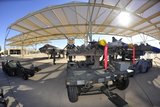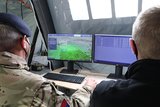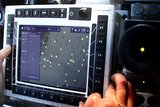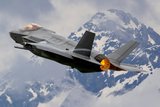The F-35 for the UK – At the Heart of Aerospace Innovation (Studio)
The UK's investment in the F-35B provides a powerful, fifth-generation capability for the Royal Air Force (RAF) and the Royal Navy (RN).
The implications are also far broader, with the fighter aircraft supporting the country's increasingly global outlook and serving as a vital tool in the transition to multi-domain operations (MDO), while also being a key driver of future aerospace innovation in the UK.
The RAF and the RN plan to acquire and operate 138 F-35B short takeoff/vertical landing aircraft.
The assets will fulfil a range of roles, forming the spine of the country's future carrier strike group (CSG) – based on the HMS Queen Elizabeth and the HMS Prince of Wales – while also serving alongside the Eurofighter Typhoon as a multi-role provider of EW, ISR, air-to-air and air-to-surface capabilities.
The platform will provide a step-change for the armed forces, particularly from a carrier perspective, said Adam Clink, Head of Carrier Strike at Lockheed Martin UK.
On 4 January, the UK Ministry of Defence announced that its new Carrier Strike Group (CSG) had reached initial operating capability, meaning all elements have been successfully brought together and operated.
The IOC milestone was 'a hugely significant step for the UK' after a decade-long gap in carrier capability, Clink said.
'It's symbolic of Britain's commitment to NATO and its partnership with the US,' he added. 'Carrier Strike Groups are a strategic asset – they're not just for the Royal Navy. It really shows our strategic influence around the world.'
Clink served as a Harrier pilot in the Royal Navy for 26 years. While the Sea Harrier and GR9 were exceptional assets for their era, this marks the first time 'that Britain has been at the cutting edge of fighter technology with a fifth-generation platform, capable of operations from land and sea in the F-35B variant', Clink said.
The aircraft marks a considerable step forward in terms of sensors, weapons, and capabilities, and perhaps most importantly, enhances the UK's credibility around the world in terms of power projection.
'This is a strike platform that's having an impact wherever it is in the globe,' Clink said.
'Lockheed Martin are consistently and continuously trying to develop that capability, to remain at the cutting edge while those global threats advance.'
Kelvin Truss is Head of Strategic Engagement for Air Programmes within Lockheed Martin UK and a former RAF pilot with more than 4,000 flying hours.
He highlighted the F-35 B's stealth capabilities, thanks to its low radar cross-section, combined with multiple sensors fused at the point of need and sophisticated self-protection systems.
'Who would not want to be invisible to opponents, be able to strike from afar, defend ourselves and be able to maintain total situational awareness throughout?' Truss argued.
Truss highlighted the aircraft's capability in close air support and as an ISR platform, both in gathering data to share with a wider network and providing this information to the pilot.
These will be critical aspects of operating in the future MDO battlefield, when assets from different services will cooperate in a far more integrated and seamless way than ever before, alongside the cyber domain and a wide range of information tools.
Such themes are a crucial focus for the UK through its Integrated Operating Concept. While the military's ability to effectively integrate air, land and maritime forces has always been important, the emergence of space, cyber and information as operating domains in their own right 'has heightened the need for comprehensive integration.
This will ensure that the synchronicity and pace needed for operational success will be achieved, especially when operating with finite resources that need to be managed as effectively [as possible] in a multi-role way', Truss said.
The F-35 has an essential role to play in this integrated future, Truss said, the aircraft operating alongside unmanned systems and other platforms to serve as a core node in an MDO battlespace.
The aircraft can help build collective situational awareness, he said, feeding the common operating picture through gathering, processing, and disseminating targeting information to the right user at the highest degree of fidelity.
'Its ability to operate at range, its ability to endure, its ability to be present at a time and place of need, and then to act as that node, that link point between space-based assets, land-based assets, maritime assets, other air assets, [mean it will] be a key player in the future.'
The UK recently announced a £16.5 billion defence spending increase, a vital component of the government's ambition for a robust and global role for the country in the years to come. This will involve close cooperation with partner nations, notably the US and other NATO allies.
The F-35 programme – as the biggest global acquisition programme in defence – encapsulates this international approach to military development, said Clink. The programme involves three US military services and 13 international partners, with 'more and more nations looking at and choosing F-35 to be their new fighter platform of choice'.
While such cooperation can, of course, reduce costs, it also 'promotes that global partnership and enhances national security', he added, while promoting economic growth in the individual nations.
The US relationship is paramount for the UK, something that has been on clear display through the F-35 acquisition process.
This is particularly the case with the US Marine Corps, which is also acquiring the F-35B and has operated seamlessly alongside the RAF and RN throughout the programme. That cooperation was demonstrated in September 2020, when Marine Fighter Attack Squadron 211 embarked ten of its F-35B aircraft onto the HMS Queen Elizabeth, joining the UK's 617 Squadron, 'the Dambusters'.
More broadly, the RN and the US Navy are working to reach 'interchangeability' between their carrier elements, even down to swapping parts and systems, Clink said.
While this could pose technical challenges, 'the ability to be interchangeable, working seamlessly together, is a significant step'. The F-35B sits at the very heart of this process.
The F-35 programme supports more than 20,000 UK jobs, involves up to 500 companies of all sizes, and is estimated to generate £40 billion for the British economy over the programme's life, according to a recent KPMG study.
Just as notably, the skills that have been built and sustained through the programme will support the future of fifth and sixth generation aircraft development in the country. The ability to develop such programmes 'gives us a standing on the global stage', Clink noted.
Operators are still discovering new potential for the F-35, Truss said. For example, he pointed to Project Riot of September 2019, when the US Air Force and the US Missile Defense Agency successfully connected F-35s with a U-2 and a multi-domain ground station.
'We're seeing air-to-air, air-to-space, air-to-land, and air-maritime interfaces all capitalising on what the F-35 can bring to bear,' he explained.
Building the right numbers of aircraft will allow the UK to exploit the flexibility that the F-35 provides, Truss added, helping the country sustain concurrent land and maritime-based operations, even in two operating theatres at once.
'Mass will be a key factor in just how much utility the F-35 can bring,' he said. 'But when we have it at full strength, I can see it being a key capability that actually defines UK 21st century integrated operations.'
More from Investing in Tomorrow (Studio)
-
![First F135 engine depot outside of US is approved]()
First F135 engine depot outside of US is approved
Netherlands F135 engine maintenance facility has been approved for initial depot capability.
-
![Lockheed Martin to continue network-centric weapons capabilities work for F-35]()
Lockheed Martin to continue network-centric weapons capabilities work for F-35
Lockheed Martin carries on developing network-enabled weapons and electronic-attack capabilities for F-35 operators in the US and allied air forces.
-
![Against a rapidly evolving air defence picture, SkyKeeper has all threats covered (Studio)]()
Against a rapidly evolving air defence picture, SkyKeeper has all threats covered (Studio)
Evolving air defence requirements drove the development of Lockheed Martin UK's SkyKeeper BMC4I solution.
-
![SkyKeeper – the enabler of air defence in the digital age (video)]()
SkyKeeper – the enabler of air defence in the digital age (video)
In response to evolving air defence challenges, Lockheed Martin UK has developed SkyKeeper - a next-generation Battle Management Command and Control capability.
-
![F-35 takes Swiss spoils to maintain remarkable European sales record]()
F-35 takes Swiss spoils to maintain remarkable European sales record
In what amounted to a fairly one-sided contest, the F-35A has emerged as the winner of Switzerland's Air2030 procurement, with Bern opting to buy 36 of the fifth-generation jets.
-
![US F-35Cs qualify for carrier operations]()
US F-35Cs qualify for carrier operations
The US ‘most advanced carrier wing’ has been qualified for Carrier operations following four days of flight deck operations earlier this month.























